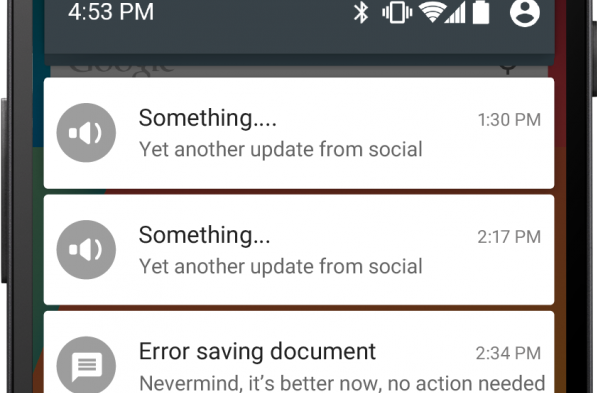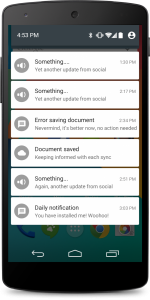Notifications are an integral part of a user's experience with a device. It's one of those areas on our phones that we see tens and possibly even hundreds of times everyday. It serves as the primary area of getting a user notified about things he cares about -- at least, that was the plan.
But app developers often overestimate the importance of their own apps. This trend affects big name companies more than indie developers, and is quite prevalent amongst games. Not saying that applications are not important to users, because they are. But as it happens far more often than it does not, developers tend to overlook the fact that their application is not the only one present on a user's phone. They assume that users need to be notified of even the smallest of actions, with the default settings of most applications depicting this philosophy.
The assumption made is that the user will uncheck those notifications that he does not care about, but fails to consider that most normal users never dabble in the settings of an app post the setup process.
So what happens when you have several apps which place the utmost of importance on themselves? Why, you end up in scenarios where you have pages of notifications to scroll through. To reach that one notification that is of importance to you, you have to swipe through ten others which are irrelevant in your current scenario.
Google has introduced various methods in the past to unclog your notification shade. There are guidelines into the best practices for notifications, for both Android 4.4 Kitkat and lower, and for Android 5.0+. App developers are encouraged to use notifications for time sensitive events which involve interactions with another human, while they are advised to stay away from notifications that have no true purpose and are superfluous in nature, made just to promote the brand or launch the app.
Use notifications primarily for time-sensitive events, especially if these synchronous events involve other people. For instance, an incoming chat is a real-time and synchronous form of communication: Another user actively waiting on your response.
Avoid notifying the user of information that is not directed specifically at them, or information that is not truly time-sensitive. For instance, the asynchronous and undirected updates flowing through a social network generally do not warrant a real-time interruption. For the users who do care about them, allow them to opt-in.
Don't create notifications that have no true notification content and merely advertise your app. A notification should provide useful, timely, new information and should not be used merely to launch an app.
Don't create superfluous notifications just to get your brand in front of users. Such notifications frustrate and likely alienate your audience.
With the general increase in hardware specifications of phones to hold more apps in storage, and with the increase in social media platforms that users partake in, the number of lower priority notifications on a phone just keeps on mounting. Add in conversational messages from various communication platforms with other assorted varieties of notifications to the tunes of "Your troops are ready for battle" and "Your fuel has been refilled!" to this mixture. The resulting mess is a hodge podge of things trying to get your attention, in which actually qualified notifications lose out.
All is not lost though. If you are looking for a way out of this quandary, there is hope.
One such hope comes to us in the form of Nevolution. We've mentioned about Nevolution back when it was in beta, and the app by Greenify Developer oasisfeng warrants another mention now that it is out of beta.
What Nevolution aims to do is to provide an easy basis for tweaking notifications. It allows you to control several aspects of the notification, such as heads-up and multi-line text. What actually makes the app stand out is the plug-in framework built into the app, which allows the evolution of notifications in an manner independent of the app developer. This opens the doors to community-driven plugins, where users decide the best way of being treated to a particular apps notifications, and share this with other users. Functionality on this front is limited at the moment, but there is certainly scope in this approach as it incentivizes developers to actively focus on an improved and non-cumbersome notification model for their app, lest they want users to take control for all of it. Either ways, the end result would be in the ultimate benefit of the user.
You can find more information on Nevolution over at the forum thread.
Nevolution works on the presentation aspect of the notification, and that too, on the end of the user. But what if there was a way to smartly and intelligently control which notifications the user gets in the first place?
This is where Projector comes in.
As per Ars Technica, Projector is a startup which aims to help developers, giving them the tools to make their notifications smarter. The idea is to disturb the user only when it is appropriate to do so. By opting for this philosophy, you instantly add actual functional value to the notifications that do go through. Notifications that are usually classified as spam or low priority, such as a Twitter post going viral, or an Instagram upload for a popular account, will get acted upon by Projector first, before it reaches the user. The Projector service will sit between the existing application servers and notifications servers, providing a middle space for rules and machine learning to be applied in these scenarios. So when such scenarios are initiated, the notification spam is minimized by utilizing batch notifications or other techniques. Projector will also utilize geofencing techniques to estimate if the user is in situations where lesser notifications are expected: such as while driving and in meetings, and appropriately prioritize notifications that would actually matter in those scenarios like a traffic update on the route.
Projector also aims to help the developers by providing feedback on what notifications are acted upon and which are dismissed by particular users. This would help create user profiles, and then allow developers to tailor requests for specific user sets. After all, the central product of a notification is a user, with his own individual taste, something which can only be so effective with a blanket rule.
Android's notifications are a mess, and it is not entirely the fault of the OS. Conscious app developers do adopt user friendly notification systems. But the ones exploiting the system are the ones which dirty the pond for all. Perhaps, Google should set up stricter guidelines for notifications, just as it did with Doze. Because with Android Wear only expected to get popular in the future, notifications that you care about will become the need of the hour.
What are your thoughts on Nevolution and Projector? Do you think Android's notification system could do with a ground-up rethinking? Let us know your thoughts in the comments below!



